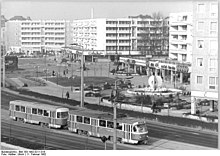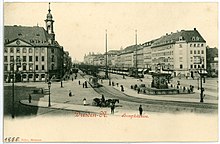Neustädter Markt (Dresden)

The Neustädter Markt is a place in the Inner Neustadt in Dresden . It was probably laid out before 1200 as the village square of a Slavic settlement in what would later become Altendresden . The Neustädter Markt is located at the intersection of Hauptstraße , Augustusbrücke , Köpckestraße and Großer Meißner Straße. Furthermore , the Rähnitzgasse, which comes from the baroque district of Königstraße , leads to the Neustädter Markt . The most important landmark of the Neustädter Markt is the equestrian statue of August the Strong , the " Golden Rider ".
Name development
In 1501 he was called "Ringk" and in 1503 "Margkt". At the end of the 18th century, the term “marketplace” was common. In the 19th century the square was called "Am Markt". In the 1920s, the name “Neustädter Markt”, which is still valid today, came up, which explicitly differentiates it from its two old town counterparts, Altmarkt and Neumarkt .
Plant and history


On the north side of the square were the Neustadt town hall and the so-called meat and bread banks. In addition, there were two public fountains that got their water from the Dresden Heath .
After the fire in Altendresden in 1685, the square was expanded. It was also planned to flank the bridgehead of the Augustus Bridge with two monumental buildings. However, only the log house was implemented as a guard building for the Neustädter Hauptwache. Opposite the log house was the house “Die Zeit”, on which was a sculpture by Balthasar Permoser , “Death with an hourglass”. Joseph Fröhlich , the court jester of August the Strong, had his house built on the adjoining property, which later became the “ Narrenhäusel ” inn . In the course of the expansion of the square, the town hall was torn down and a new one was built on the north side. The town planners at the time moved the two fountains to the corners of the houses at the entrance to the main street. They had two water houses with copper tent roofs built in place of the wells. These two buildings were demolished in 1895.
From 1864 the Striezelmarkt took place several times on the market and in the adjacent main street.
The bombing of Dresden in World War II resulted in the complete destruction of the Neustädter Markt and the neighboring buildings. A new development of the square by the development plan Innere Neustadt took place in the 1970s. Since then, it has been designated as a pedestrian zone together with the main street. The traffic was concentrated on the Große Meißner Straße (now part of the federal highway 170 ), which crosses a pedestrian tunnel at the level of the market, which connects it with the Augustusbrücke. After the tunnel was completely flooded by the Elbe water during the August flood in 2002 and repeatedly during the June flood in 2013 , it had been completely closed since June 2013. The Gesellschaft Historischer Neumarkt Dresden , the Greens faction in the city council and the Neustadt local councils (since 2018: city district councils) favor a complete backfill and a better level crossing of the federal road. A corresponding resolution was passed by the city council in January 2015. The tunnel was backfilled in winter 2016/2017.
Statues, fountains and works of art
Golden rider
The largest and most well-known work of art on Neustädter Markt is an equestrian statue of Augustus the Strong - the Golden Rider by Ludwig Wiedemann . The work began in 1732 while the Saxon elector and Polish king was still alive and was completed after his death (1733) under his son and successor Friedrich August II with the unveiling on November 26, 1736.
The memorial was dismantled and relocated in 1943/1944, which meant that it was not exposed to the destruction caused by the Allied air war . It was re-erected in 1956 as part of the 750th anniversary of the city of Dresden.
More works of art
During the reconstruction, salvaged architectural fragments were restored and installed in new locations on Neustädter Markt.
There are also two 20-meter-high bronze flagpoles at the transition to the main road. Heinrich Epler created it in 1893 to commemorate the visit of Kaiser Wilhelm I to Dresden. The masts are each decorated with a relief image of Wilhelm I and the Saxon King Albert . The balustrade and benches are made of Swedish granite. The model for these flagpoles were two masts from the 16th century in Venice by Alessandro Leopardi .
On the side of the pedestrian tunnel facing the Elbe, four sandstone reliefs, created in 1978/1979, show views from different points in the history of Dresden . Old Dresden around 1640 by Dietrich Nitzsche , Dresden (Neustadt and Altstadt) in the 17th century by Vinzenz Wanitschke , Altendresden and the old town in the 18th century by Egmar Ponndorf as well as Peter Makolies ' relief of the main street and the Neustädter Markt before 1945.
Fountain
There are two sandstone nymph fountains on Neustädter Markt that were created by Johann Benjamin Thomae from 1738 to 1742 . These wells are now approximately 12 meters from their original location. In each case a nymph is depicted, which is played around by mythical creatures. Fish mouths serve as water dispensers. Small water outlets are attached to the front pedestals. The fountains were restored in 1889 by the sculptor Fehrmann. In 1938 the statues were replaced by copies by Paul Polte . The figures, damaged in 1945, were restored in 1979 by Werner and Christian Hempel .
Furthermore, two similarly designed concrete fountains by Friedrich Kracht are set up on the east and west sides . The pools are 15 meters in diameter and have three-part fountain blades. The reconstruction of these wells took place in 1995.
literature
- Stadtlexikon Dresden A-Z . Verlag der Kunst, Dresden 1994, ISBN 3-364-00300-9 .
- Art in public space . Dresden Cultural Office, Dresden 1996.
Footnotes
- ↑ No revival for Neustädter Tunnel! In: neustaedtermarkt.de. Society of Historical Neumarkt Dresden e. V., July 11, 2013, accessed on August 19, 2014 .
- ↑ Steffen Füssel: Neustadt pedestrian tunnel should go. In: Sächsische Zeitung (via neustaedtermarkt.de). November 6, 2013, accessed August 19, 2014 .
- ↑ Final act at the Neustädter Tunnel. In: Saxon newspaper . February 20, 2017, accessed April 13, 2020 .
Web links
- Projects, plans & pictures from the Neustädter Markt in Dresden
- neustaedtermarkt.de - Citizens' initiative for reconstruction projects on Neustädter Markt
Coordinates: 51 ° 3 ′ 29.6 " N , 13 ° 44 ′ 29.2" E






